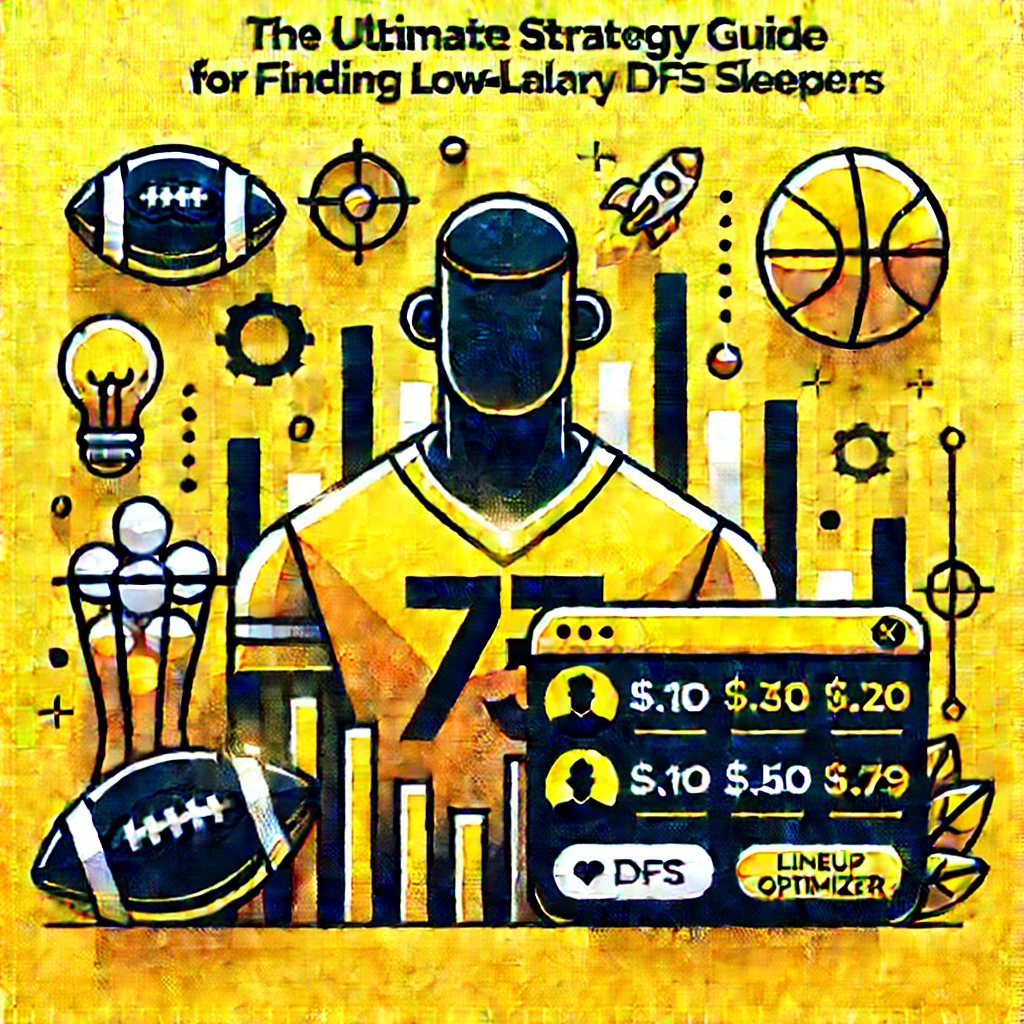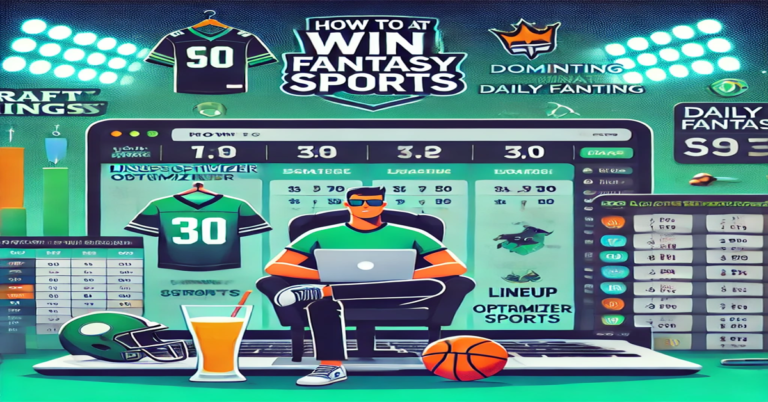The Ultimate Strategy Guide for Finding Low Salary DFS Sleepers
Daily Fantasy Sports (DFS) offers an exciting and fast-paced way to enjoy sports while testing your analytical skills. However, one of the most challenging aspects of DFS is identifying value plays—players who deliver solid performance at a lower cost, also known as “low salary DFS sleepers.”
In this comprehensive guide, we will cover strategies to help you find and maximize these low-cost players in DFS. By the end of this article, you’ll have the tools to consistently outperform your competition by identifying under-the-radar players who can contribute significantly to your lineups.
Table of Contents
- What Are Low Salary DFS Sleepers?
- Why Low Salary DFS Sleepers Matter
- How to Identify DFS Sleepers: Key Factors
- Using Projections and Tools to Spot Sleepers
- Breaking Down Sleepers by Position
- Long-Term Strategies for DFS Sleepers
- DFS Sleepers to Avoid: Common Pitfalls
- Case Studies: Successful DFS Sleeper Picks
- Conclusion: Mastering the Art of DFS Sleepers
What Are Low Salary DFS Sleepers?
A low salary DFS sleeper is a player in daily fantasy sports contests who is priced lower than premium options but has the potential to outperform their salary-based expectations. These players are typically under the radar, not receiving much attention from the general DFS community due to various factors such as lack of recent production, playing on a lesser-known team, or coming off an injury. However, when chosen wisely, sleepers can provide significant upside and return on investment, making them key assets for building competitive DFS lineups.
DFS sites like DraftKings and FanDuel assign player salaries based on their performance, recent statistics, and projected output. Top-tier players are usually priced high, which means it’s difficult to create a balanced lineup without dipping into the lower salary pool. This is where low salary sleepers become vital: they allow DFS players to roster high-cost stars while staying under the salary cap.
Identifying sleepers requires research, an understanding of various factors, and a touch of intuition. But when executed correctly, this strategy can drastically improve your DFS performance and profits.
Why Low Salary DFS Sleepers Matter
DFS is all about finding value. High-priced players can drain your salary cap quickly, leaving you with limited options for the rest of your roster. The ability to unearth low salary sleepers provides flexibility, enabling you to afford a few elite players in your lineup.
Sleepers play an essential role in creating diversified lineups, especially in large-field tournaments. In tournaments, “chalk” players (those who are highly owned) can only take you so far. Contrarian picks—low-owned sleepers—help you differentiate your lineup from the rest, giving you an edge when these players overperform.
Moreover, identifying sleepers allows you to stay within budget constraints while assembling a competitive team, particularly in cash games where you’re aiming for consistent points rather than high volatility.
How to Identify DFS Sleepers: Key Factors
Injury Reports and Depth Charts
One of the most common ways to find low salary DFS sleepers is by monitoring injury reports. When a key player gets injured, the backup often steps into a larger role but is still priced at a low salary because DFS sites haven’t yet adjusted their value. This creates a prime opportunity to exploit low-cost players in an expanded role.
Depth charts also offer insight into potential sleepers. A player who’s third on the depth chart one week could move up due to injuries or a coach’s decision, presenting a significant sleeper opportunity. Staying up-to-date with depth charts and team news can help you identify these under-the-radar gems before the rest of the DFS community catches on.
Recent Form and Momentum
DFS is very much about riding the hot hand. Low salary players who are starting to find their form or have shown recent flashes of brilliance can make for excellent sleeper picks. Players often hit a purple patch of form for a few games, during which they consistently outperform their price tag. However, DFS pricing algorithms may not react fast enough to a short-term uptick in performance, allowing savvy DFS players to take advantage.
Additionally, looking at players’ recent performance trends and underlying metrics (e.g., snap counts, targets, or usage rates) can provide valuable clues on whether they are poised for a breakout performance.
Game Script Predictions
Understanding how a game is likely to play out is critical in DFS strategy, especially when targeting sleepers. In blowout games, backups may get more playing time, presenting sleeper opportunities. Conversely, if a game is expected to be a shootout, lower-priced wide receivers or running backs on both teams could see increased volume.
Anticipating the game script and how it will affect the usage of different players helps you select low-cost sleepers who might see a greater role than expected.
Player Matchups and Opponent Weaknesses
The matchups players face in DFS are one of the biggest determinants of their success. A backup running back may not seem enticing on the surface, but if they’re going up against one of the league’s worst rushing defenses, they immediately become a viable sleeper option. Similarly, wide receivers facing weak secondaries or cornerbacks with poor track records in coverage can deliver strong performances at low prices.
Analyzing defensive metrics, such as yards allowed per play, third-down conversion rates, or pressure rates, can give you insight into which low-cost players might exploit a favorable matchup.
Team Dynamics and Game Context
Team dynamics also play a role in identifying DFS sleepers. Consider situations where coaches are looking to rest starters, especially late in the season when playoff-bound teams may give more opportunities to backups. Additionally, when a team has nothing to play for, lower-salaried players may get extended looks as the coaching staff evaluates talent for the future.
In DFS sports like NBA or MLB, where there are multiple games per week, rotational players can get more minutes or at-bats, depending on the game context and strategy employed by the coaching staff. Understanding these dynamics allows you to capitalize on player usage that isn’t immediately obvious from basic stat lines.
Using Projections and Tools to Spot Sleepers
DFS Optimizers and Lineup Generators
DFS optimizers and lineup generators have become essential tools for daily fantasy players. These tools allow you to input specific parameters, such as salary constraints, player exposure, and projected points, to create optimized lineups. While optimizers typically prioritize high-projected players, they also highlight low-salary sleepers who are expected to perform well in certain matchups.
By using advanced algorithms, these tools can help you identify which low-salary players have the best chances of returning value. Many optimizers also allow you to build multiple lineups, ensuring you spread out your sleeper picks across various contests, reducing risk while increasing potential rewards.
Value Metrics: Fantasy Points Per Dollar
One of the most important metrics to consider when identifying sleepers is fantasy points per dollar (FP/$). This metric essentially calculates the expected return on investment (ROI) of each player relative to their salary. A high FP/$ indicates that the player is providing good value for their cost, making them an attractive option for DFS lineups.
For example, if a player costs $4,000 and is projected to score 12 points, their FP/$ would be 3.0, which is considered excellent for a low-cost option. Sleepers with high FP/$ can allow you to build balanced lineups with both high-floor and high-ceiling players.
Utilizing Expert Picks and Consensus Rankings
Expert picks and consensus rankings from DFS analysts are invaluable tools for DFS players. These experts often identify low-cost sleepers who may not be obvious to casual players but have significant upside based on matchups, injuries, or recent performance trends.
Consensus rankings aggregate opinions from multiple DFS experts, providing a more comprehensive picture of which sleepers are gaining momentum. These rankings are particularly useful for identifying contrarian picks—players who have the potential to differentiate your lineup in large-field tournaments.
Breaking Down Sleepers by Position
Quarterback Sleepers in NFL DFS
Finding a low-salary quarterback sleeper can be tricky, as this position often drives the most points in a lineup. However, quarterbacks who step into a starting role due to injury, or mobile quarterbacks who can generate points on the ground, often provide great sleeper value.
For instance, a backup quarterback stepping into a favorable matchup against a weak secondary can outperform their low salary, making them a valuable DFS sleeper. Additionally, rookie quarterbacks or those with rushing upside are often undervalued, but they can post significant fantasy points by contributing both through the air and on the ground.
Running Back Sleepers in NFL DFS
Running back sleepers are perhaps the most common and effective sleepers in NFL DFS. Injuries to starting backs often thrust backups into significant roles, offering substantial value at a lower price. Additionally, teams may use a committee approach, where a lower-salary running back could see an increased workload, particularly in goal-line situations.
In DFS, game script can heavily influence running back usage. If a team is projected to win by a large margin, their running backs might see more touches in the second half, particularly in clock-killing scenarios. Identifying these situations allows you to capitalize on cheap running back sleepers.
Wide Receiver Sleepers in NFL DFS
Wide receivers are volatile by nature, but this volatility presents excellent opportunities for finding sleepers. A low-cost wide receiver who sees an increase in targets due to injury or favorable matchups can return immense value in DFS. When targeting wide receiver sleepers, look for players who are seeing an uptick in snap count, target share, or those benefiting from injuries to other pass-catchers.
Slot receivers, in particular, often fly under the radar but can rack up receptions and yardage, especially in PPR (points per reception) DFS formats. Additionally, deep-threat receivers who only need one or two big plays to hit value can be worthwhile low-salary gambles in tournament lineups.
Tight End Sleepers in NFL DFS
Tight ends are often underutilized in DFS lineups, but finding the right sleeper at this position can give you a significant edge. Tight end sleepers typically emerge when they step into a bigger role due to an injury to a starting player or when they face a defense that struggles to contain the position. Given the low scoring floor of the tight end position in DFS, any player who can catch a touchdown pass instantly returns value.
Additionally, low-salary tight ends who see a steady volume of targets, particularly in red-zone situations, are worth considering as sleepers.
NBA DFS: Low Salary Guards
In NBA DFS, low-salary guards can be sleepers when they step into a larger role due to injuries, rest days, or favorable matchups. Guards who handle the ball frequently have a higher chance of accumulating fantasy points through assists, steals, and three-pointers. Backup guards who fill in for injured starters can also see an increase in minutes, giving them more opportunities to contribute across multiple statistical categories.
When targeting NBA sleepers, look for guards on teams playing at a fast pace or in games with a high projected point total. High-pace games offer more possessions and scoring opportunities, increasing the sleeper guard’s chances of outperforming their salary.
NBA DFS: Low Salary Forwards and Centers
Forwards and centers in NBA DFS can offer sleeper value when they step into a starting role or face a team that struggles defensively against big men. Power forwards and centers who can grab rebounds, block shots, and score efficiently around the basket often provide high FP/$ ratios. Moreover, versatile forwards who contribute in multiple categories—points, rebounds, assists, and steals—can provide excellent value as DFS sleepers.
Injuries to key frontcourt players can thrust low-salary forwards or centers into expanded roles, making them strong sleeper candidates. Keep an eye on player minutes, usage rates, and matchups to identify these value plays.
Long-Term Strategies for DFS Sleepers
Tracking Trends and Player Development
To consistently find DFS sleepers, it’s essential to track player trends and development over time. Rookies and young players often take a few weeks or months to adjust to the professional level, but once they hit their stride, they can provide excellent value before their salary catches up. Similarly, veterans who start the season slow but begin to find their form are often undervalued in DFS.
By staying on top of player trends, you can anticipate when a low-salary player is about to break out, giving you a significant edge over other DFS players.
Exploiting Ownership Percentages
Ownership percentage refers to how many DFS players are selecting a particular player in their lineups. In large-field tournaments, exploiting low-ownership sleepers is a key strategy. If a sleeper performs well and is only rostered by a small percentage of DFS players, you gain a considerable advantage in terms of uniqueness and potential payout.
By identifying sleepers who are flying under the radar but have significant upside, you can build contrarian lineups that have the potential to win big in tournaments.
Monitoring Line Movement and Vegas Odds
DFS players can gain valuable insights from monitoring Vegas odds and line movement. When the line for a game moves significantly in one direction, it can indicate changes in game conditions such as injuries, weather, or late-breaking news. DFS players who can interpret these changes can identify value plays and sleepers that others might miss.
For example, if the point total for an NFL game rises significantly, it could indicate that more points are expected to be scored, increasing the value of low-salary skill position players. Similarly, monitoring over/under totals in NBA games can help you identify which matchups are expected to produce more fantasy points, making it easier to spot low-cost sleeper plays.
Utilizing Weather Conditions in NFL and MLB DFS
Weather conditions can have a significant impact on player performance, particularly in outdoor sports like NFL and MLB. In football, rain, wind, or snow can drastically alter the way teams play, leading to increased opportunities for running backs or kickers. In baseball, wind patterns and temperature can affect how the ball travels, impacting home run potential and pitching matchups.
By factoring in weather conditions, you can identify DFS sleepers who are positioned to benefit from the elements, giving you a strategic advantage over other players who may overlook this aspect.
DFS Sleepers to Avoid: Common Pitfalls
Overhyped Players with Low Ceilings
Not every low-salary player is worth considering as a sleeper. Some players may be hyped due to recent media attention or a single standout performance, but if they have a low ceiling and limited opportunity for sustained success, they are risky picks. These players may have a decent floor, but their lack of upside makes them poor choices for tournaments where you need high-scoring players to differentiate your lineup.
Misinterpreting Preseason or One-Game Wonders
Preseason performances or single-game outliers can often lead to overvalued players in DFS. A player who excels in a limited sample size may not be able to replicate that performance over a larger period, especially if their role in the team is not clearly defined. Be cautious when considering players who have shown flashes of brilliance but lack consistency or a clear path to sustained usage.
Case Studies: Successful DFS Sleeper Picks
One of the best ways to learn about identifying sleepers is by examining real-life examples. Over the years, many DFS players have unearthed successful sleepers who went on to outperform their low salaries and lead to tournament victories.
In this section, we’ll look at a few recent examples of sleeper picks in various sports and break down the factors that led to their success. We’ll analyze their matchups, game context, and DFS ownership percentages, offering valuable insights into what made these players excellent sleeper picks.
Conclusion: Mastering the Art of DFS Sleepers
Identifying low salary DFS sleepers is a skill that separates the average daily fantasy player from the elite. By understanding key factors like injury reports, matchups, game scripts, and team dynamics, and using tools such as lineup optimizers and projections, you can consistently find underpriced players who deliver strong fantasy performances.
While finding sleepers requires research, patience, and a bit of risk-taking, the potential rewards are immense. Whether you’re playing NFL, NBA, or any other DFS format, mastering the art of sleeper selection will allow you to build optimized lineups that give you an edge over the competition.



